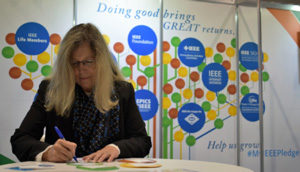Attendees at this year’s IEEE Sections Congress were encouraged to sign a pledge wall to commit to an action, whether with “time, talent, or treasure.” The group surpassed its goal of inspiring 250 members to pledge.
Photo: IEEE Humanitarian and Philanthropic Opportunities
Source: http://theinstitute.ieee.org/ – Article by Monica Rozenfeld, 12 October 2017
True to its mission of advancing technology for humanity, IEEE has programs across the organization aimed at improving quality of life. They include bringing electricity to remote regions via the IEEE Smart Village Initiative, partnering students with engineers to tackle problems in their communities through EPICS in IEEE, and teaching students the impact of technology throughout history with the IEEE REACH program. With dozens of projects to choose from across various programs, how do members decide which to get involved in?

IEEE President Karen Bartleson makes the first pledge at the IEEE Humanitarian and Philanthropic Opportunities pavilion at Sections Congress. (Photo: IEEE Humanitarian and Philanthropic Opportunities)
To help, 10 groups have united to form the Humanitarian and Philanthropic Opportunities (H&P) Initiative, providing for the first time a one-stop shop where members can discover opportunities that best match their interests, expertise, and availability. The initiative launched at the IEEE Sections Congress, held in August in Sydney, and was organized by the IEEE Foundation and the IEEE Humanitarian Activities Committee (HAC). Visitors to the H&P pavilion were encouraged to sign a pledge wall to commit to an action, whether with “time, talent, or treasure.” The group surpassed its goal of inspiring 250 members to pledge.
“Humanitarian technology activities are part of the value of membership,” says IEEE Fellow Leah Jamieson, 2007 IEEE president and 2012–2016 president of the IEEE Foundation. “Members can be proud of the good the organization is doing in the world.”
Getting Involved
The H&P pavilion volunteers helped attendees narrow down potential activities with a decision tree. The chart begins by asking which career stage a member is in. The member then could choose between short- and long-term projects as well as a specific type of activity, such as ones focused on developing government policy or improving education.
Say you’re a young professional looking for a short-term opportunity due to your busy schedule. One activity to consider is your local IEEE Special Interest Group on Humanitarian Technology (SIGHT). Groups work on projects such as modernizing infrastructures, using technology to improve farming in communities, and developing assistive technologies for people with disabilities. Another opportunity is to provide technical expertise for the IEEE Internet Initiative, which supports programs and collaborations that expand services to the more than half of the world’s population that is without Web access. The initiative’s volunteers help inform global policy discussions.
“There are more projects members are likely to be surprised they can get involved in,” says IEEE Life Fellow Michael Lightner, the 2006 IEEE president. He, along with 2014 IEEE President J. Roberto de Marca, helped establish the HAC. The committee supports IEEE volunteers carrying out humanitarian activities in their community.
One example of an HAC project is a partnership with AnnieCannons. Based in San Francisco, the organization helps survivors of human trafficking by teaching them Web programming skills and then matching them with potential employers. The organization also welcomes programmers to help design software that combats human trafficking. “For many of our members, this organization is right in their backyard,” Lightner says. “These young women often have no money or education, and may not speak English. Now they have a trade.”
Then there’s a makerspace in South Africa in the Eastern Cape region. The space is equipped with mechanical and electrical tools and machines. IEEE members from a local university help train people in the community to use the tools. The space facilitates the repair of car parts, and building them from scratch. It also supports artists and artisans, and boosts the local economy. The tools and engineering skills give community members the ability to be self-reliant, Lightner says.
“There is a huge variety of projects that have been suggested by members in their local areas that we support,” he says. “Members are connected to their communities and see the needs that we can’t. It’s amazing what they bring to us.”
Other groups participating in the initiative include the IEEE Life Members committee, which sponsored the Sections Congress this year along with the IEEE Foundation; IEEE–Eta Kappa Nu, the organization’s honor society; the IEEE History Center; and the IEEE Power & Energy Society Scholarship Plus Initiative.
Next Steps
The H&P pavilion volunteers and staff are keeping the momentum from the congress going by helping those who pledged to aid a specific initiative to take the next step. Moving forward, the group might set up its booth at several IEEE flagship conferences and potentially at events with other philanthropic organizations such as Engineers Without Borders. “The goal is for those who work on humanitarian efforts to support one another and work together,” Lightner says.
“We have to form partnerships so that we better understand the needs of people and do good in the world,” he says. “It’s not technology first; it’s people first.”
To get involved, visit the Humanitarian and Philanthropic Opportunities website.
IEEE membership offers a wide range of benefits and opportunities for those who share a common interest in technology. If you are not already a member, consider joining IEEE and become part of this worldwide network of more than 400,000 students and working professionals.

Recent Comments